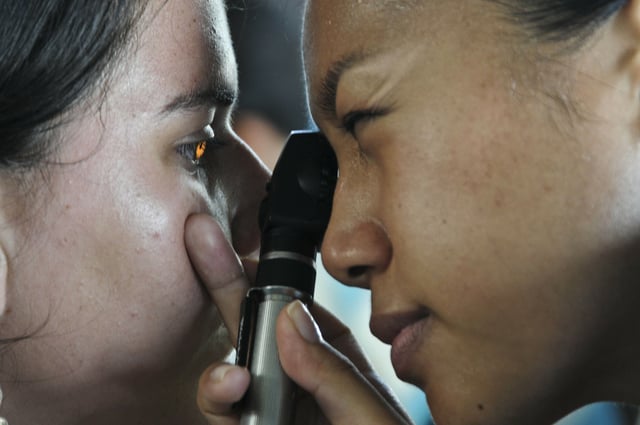
Photo by Soroush Karimi on Unsplash
You already know the famous quote "the eyes are the windows to the soul," (attributed to Shakespeare, Cicero, and Matthew 6:22-23 in the King James Version of the Bible, and many others.) But they’re also the windows into health--not simply the organs we use to see the world. In fact, their importance in health care can’t be overlooked (pun intended.) Here’s some evidence:
A recent study conducted by the HCMS Group found that employers offering stand-alone vision benefits saved $5.8 billion over four years. These cost savings were due entirely to the preventative nature of vision work. The study found that by carrying out regular, non-invasive eye exams, optometrists identified early signs of chronic diseases that might otherwise have gone unnoticed.
- 34% of new diabetes cases were first identified through a routine eye exam, saving $28,111 per 1,000 employees over four years.
- 39% of new high blood pressure cases were first identified through a routine eye exam, saving $34,617 per 1,000 employees over four years.
- 63% of new high cholesterol cases were identified through a routine eye exam, saving $33,728 per 1,000 employees over four years.
For every dollar a company invests in vision benefits, the study found, it receives $1.45 through lower healthcare costs, improved productivity and lower turnover rates. Further, individuals who receive an annual comprehensive eye exam were more likely to enter the healthcare system earlier for treatment of serious health conditions, significantly reducing their long-term cost of care.

Photo credit: pixabay.com
WHAT CAN AN EYE EXAM REVEAL?
Nearsightedness. If you are nearsighted, the most common problem with the eyes, you have difficulty seeing objects at a distance. Nearsighedness is a growing concern: a recent study by the National Eye Institute showed the prevalence of nearsightedness (aka myopia) grew from 25% of the U.S. population (ages 12 to 54) in 1971-1972 to 41.6% in 1999-2004.
Farsigntedness: This means you can see objects at a distance, but have trouble focusing on those that are closer. About 25% of Americans are farsighted.
Astigmatism. Astigmatism usually is caused by an irregularly shaped cornea. Instead of the cornea having a symmetrically round shape (like a baseball), it is shaped more like a football. The result? Vision can be blurred or distorted at all distances. There are a few different types of astigmatism, which may add up to 40% of eye issues.
Glaucoma. Glaucoma is a disease that damages the eyes’optic nerve. It happens when fluid builds up in the front part of the eye, increasing pressure in the eye, eventually damaging the optic nerve. There are usually no symptoms with glaucoma, especially in its early stages, but it’s the leading cause of blindness in people over 60--and can be prevented with early treatment.
Diabetic Retinopathy: People with diabetes can have an eye disease called diabetic retinopathy. This happens when high blood sugar levels cause damage to blood vessels in the retina, and the vessels can swell and leak.There may not be any early symptoms, which means that an eye exam may be the first clue that someone has diabetes. Roughly 90% of diabetes-related blindness can be avoided by getting an annual eye exam.
High Blood Pressure: Blood vessels in the eye may exhibit bends, kinks or tears, and this may be an indication of high blood pressure.
And that’s not all. Autoimmune disorders, high cholesterol, aneurysms, thyroid disease, skin cancers, macular degeneration, certain cancer tumors, and other diseases can be detected in a comprehensive eye exam.
BUT VERY FEW PEOPLE GET REGULAR EYE EXAMS
Surprisingly, according to a survey conducted by Lighthouse International, only a minority of those most at risk get a regular eye exam that could detect a vision problem and the help needed to delay, prevent, or even reverse its progression. Nearly 86% of those who already have an eye disease don’t get routine exams.

Photo by Michael Mims on Unsplash
For children, it’s estimated that 80% of information taught in schools is presented visually, so it makes sense for them to have regular screenings in order to keep up academically. But according to the American Optometric Association, an estimated 20% of preschool children have untreated vision problems. Other research shows that 24% of teens with correctable vision errors don't have their vision fully corrected with up-to-date prescription eyeglasses or contact lenses.
SO WHY DON’T PEOPLE MAKE AN EYE EXAM A PRIORITY?
The 5 most commonly cited reasons are:
- No eye care insurance
- No time
- No symptoms
- Too far to travel to an eye doctor
- Their primary care physician never mentioned the need for routine eye care

Photo credit: www.opticiantraining.org
WHAT CAN BE DONE?
--Eye care insurance should be part of every employer’s basic health benefits package for employees and their families.
--Mobile eye exams (like 2020-On-site) should be more common in both urban and rural areas.
--Physicians should stress the importance of regular eye exams as a standard of care for their patients.
--Eye care insurance should be part of publicly funded insurance.
--Schools should offer routine vision care for their students.
TO LEARN MORE:
Of course, as an HR professional, you can’t be expected to solve all of these problems--but you and your company can make a difference. Download our e-book, 6 Eye-Opening Facts That Prove Your People Need Eye Exams, and find out how 2020 On-site’s mobile vision centers are part of the solution.
Not convinced? See what your ROI would be if you partnered with 2020 On-site.



